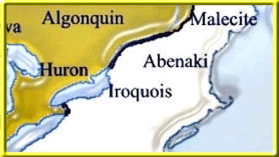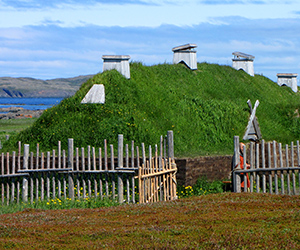CANADA HISTORY
Iroquois

The history of the Iroquois before contact with Europeans is rich and complex. The Iroquois were a confederacy of several Native American tribes who lived in what is now the northeastern United States and southeastern Canada. The five original tribes of the confederacy were the Mohawk, Oneida, Onondaga, Cayuga, and Seneca. Later, the Tuscarora tribe joined the confederacy, making it the Six Nations.
The Iroquois were a highly organized society with a sophisticated political system. They had a form of democratic government in which leaders were elected by the people and decisions were made by consensus. They also had a matrilineal kinship system, in which descent was traced through the mother's line and property was passed down through the female line.
The Iroquois were skilled farmers and traded with other tribes for goods such as furs and weapons. They also engaged in intertribal conflicts, but the confederacy provided a way for the tribes to resolve disputes peacefully.
Before contact with Europeans, the Iroquois lived in longhouses, which were large structures made of bark and poles. They practiced a religion that included a belief in spirits, the use of dream quests to communicate with the spirit world, and the performance of rituals to ensure good health, bountiful crops, and success in hunting.
The exact timing and details of the migration of the Iroquois from Asia to North America are not known, as this event predates written history. However, the prevailing theory is that the ancestors of the Iroquois, like many other Native American groups, migrated to North America from Asia over a land bridge that once connected the two continents across the Bering Strait.
It is estimated that this migration occurred thousands of years ago, likely during the last ice age when sea levels were lower and a broad plain extended from Asia to North America. The migrants, who were likely hunters and gatherers, followed game across the land bridge and eventually settled in various parts of North America. Over time, these groups developed their own unique cultures, languages, and traditions.
The Iroquois, specifically, are thought to have originally lived in the Great Lakes region before eventually settling in the northeastern United States and southeastern Canada. There, they established their confederacy and created a sophisticated society that lasted for centuries before contact with Europeans.
The relations between the Iroquois and other indigenous groups varied over time and were influenced by a number of factors, including trade, territorial disputes, and alliances.
In some cases, the Iroquois formed alliances with other indigenous groups, especially during times of conflict with European colonizers or other Native American tribes. For example, they were allied with the Hurons, who were their trading partners, against the Algonquian tribes in the Beaver Wars of the 17th century.
In other cases, the Iroquois were in competition with other indigenous groups, particularly over access to resources such as land and hunting grounds. They engaged in intertribal conflicts, sometimes using their confederacy as a means of exerting military power over other tribes. For instance, the Iroquois were in conflict with the Susquehannocks in the 1600s, which led to the decline of the Susquehannocks and the expansion of the Iroquois' territory.
In some instances, the Iroquois established trade relationships with other tribes, exchanging goods such as furs, maize, and other agricultural products. They also played a significant role in the trade networks that existed between various Native American tribes and European colonizers, which allowed them to acquire goods such as metal tools and weapons.
In conclusion, the relations between the Iroquois and other indigenous groups were complex and dynamic, shaped by a variety of factors, including trade, military power, and territorial disputes. However, despite these conflicts, the Iroquois maintained a rich cultural tradition and played a significant role in the history of Native American peoples in North America.
The Iroquois had a unique and sophisticated political structure known as the Iroquois Confederacy or the Five Nations (later Six Nations). It was a confederacy of several Native American tribes, including the Mohawk, Oneida, Onondaga, Cayuga, Seneca, and Tuscarora. The confederacy was formed in the 15th or 16th century, and its formation marked a major turning point in the political history of the Haudenosaunee (Iroquois) people.
The political structure of the Iroquois Confederacy was based on a democratic system of government, in which leaders were elected by the people and decisions were made by consensus. The political system was governed by a constitution known as the "Great Law of Peace," which established a system of checks and balances to prevent abuse of power.
The confederacy was headed by a council of chiefs, each representing one of the member tribes. The council was responsible for making decisions on matters affecting the confederacy as a whole, such as issues related to war, peace, trade, and diplomacy.
In addition to the council of chiefs, the confederacy also had a judiciary system, in which disputes were resolved by a panel of judges. This system helped to maintain peace and order within the confederacy, and it provided a means for resolving conflicts in a peaceful and just manner.
The political structure of the Iroquois Confederacy had a profound impact on the development of the United States and its government. The Iroquois' system of government was a source of inspiration for many of the founding fathers of the United States, who saw the confederacy as a model for a new form of democratic government. The idea of a federation of states, with a central government responsible for making decisions on matters affecting the entire country, was heavily influenced by the political structure of the Iroquois Confederacy.
Today, the Iroquois Confederacy continues to play a significant role in the lives of the Haudenosaunee people, and its legacy remains an important part of the history and culture of North America.
The Iroquois obtained their food from a variety of sources. They were skilled farmers and grew crops such as maize, beans, and squash, which were the staples of their diet. They also hunted and fished for food, and they traded with other tribes for goods such as furs and weapons.
Agriculture was an important part of Iroquois life, and the growing season was a time of intense activity. Women were responsible for planting, tending, and harvesting the crops, and the food was stored for use throughout the year. In addition to the crops they grew, the Iroquois also gathered wild plants and berries, which were an important source of nutrition.
Hunting and fishing were also important sources of food for the Iroquois. They hunted a variety of game, including deer, bear, and other small mammals, as well as birds and fish. The hunting and fishing grounds were carefully managed to ensure that the resources were not over-exploited.
The Iroquois were also skilled traders, and they established a network of trade routes that extended throughout the northeastern United States and Canada. They traded with other tribes for goods such as furs, salt, and shells, which were used for various purposes, including currency and decoration.
In conclusion, the Iroquois obtained their food from a combination of agriculture, hunting and fishing, and trade with other tribes. They were skilled at managing their resources and adapting to the changing seasons and conditions, which allowed them to thrive in the northeastern United States and Canada for thousands of years.
The Iroquois had a complex spiritual belief system that was deeply integrated into their daily lives. They believed in a supreme being, known as the "Creator," who was responsible for the creation of the world and all living things. They also believed in a variety of spirits, both good and evil, which were associated with the natural world, such as the spirits of animals, plants, and the elements.
The Iroquois believed that the spirits were capable of intervening in the world of humans, and they sought to maintain a positive relationship with the spirits through offerings, ceremonies, and other rituals. For example, they would offer tobacco to the spirits to ask for their help and protection.
The Iroquois also had a rich tradition of storytelling, and they passed down their spiritual beliefs and myths from generation to generation through oral tradition. These stories often had a moral or spiritual lesson, and they served as a way to teach the young about the beliefs and customs of the community.
One well-known Iroquois myth is the story of the "Three Sisters," which tells the story of the creation of maize, beans, and squash. According to the myth, the three sisters were born from the womb of the earth, and they were given to the people as a gift from the Creator. The three sisters are considered sacred by the Iroquois, and they represent the importance of agriculture and the connection between humans and the natural world.
Another important aspect of Iroquois spiritual beliefs was the concept of the "Great Spirit Road," which was believed to be a path that the spirits traveled between the spiritual world and the world of humans. The Great Spirit Road was seen as a way to maintain balance and harmony between the two worlds, and it was considered a sacred path that was not to be disturbed.
In conclusion, the spiritual beliefs and myths of the Iroquois were a central part of their culture and daily lives. They believed in a complex spiritual world that was deeply intertwined with the natural world, and they sought to maintain a positive relationship with the spirits through offerings, ceremonies, and other rituals. Today, these beliefs and myths continue to play a significant role in the lives of the Haudenosaunee (Iroquois) people, and they remain an important part of their cultural heritage.
The Iroquois have a rich tradition of art and storytelling that is an important part of their cultural heritage. Their art and storytelling reflect their beliefs, values, and experiences, and they serve as a way to pass down their history and traditions from generation to generation.
Iroquois art is characterized by a distinctive style that is highly decorative and often symbolic. They were skilled in a variety of art forms, including basketry, pottery, wood carving, beadwork, and textiles. Baskets and pottery were used for both practical and decorative purposes, and they were often decorated with intricate designs and patterns that symbolized important events, beliefs, and stories.
Wood carving was also an important form of art for the Iroquois, and they created carved masks, statues, and other objects that were used in spiritual ceremonies and rituals. Beadwork and textiles were used to decorate clothing, bags, and other items, and they often featured intricate patterns and designs that had special meanings.
In terms of storytelling, the Iroquois have a long tradition of oral storytelling that has been passed down from generation to generation. Their stories often have a moral or spiritual lesson, and they serve as a way to teach the young about the beliefs and customs of the community. Many of these stories are still told today, and they continue to play a significant role in the lives of the Haudenosaunee (Iroquois) people.
The Iroquois also have a rich tradition of storytelling through dance, music, and theater. They perform dances and songs that tell important stories and celebrate important events, such as the arrival of spring, the harvest, and the hunting season. They also perform plays and skits that feature masked characters and tell important stories.
In conclusion, the art and storytelling of the Iroquois are an important part of their cultural heritage, and they serve as a way to pass down their beliefs, values, and experiences from generation to generation. Today, these traditions continue to play a significant role in the lives of the Haudenosaunee (Iroquois) people, and they remain an important part of their cultural identity.
Warfare was a significant aspect of life for the Iroquois, and they engaged in battles and raids with other indigenous groups for a variety of reasons, including territorial disputes, control of resources, and revenge for past wrongs.
One of the most important enemies of the Iroquois were the Huron, who lived to the north of the Iroquois territory. The Huron and Iroquois were in competition for control of the fur trade, and their conflicts often escalated into full-scale wars. The Iroquois also had conflicts with the Algonquin, who lived to the northeast of their territory, as well as with other indigenous groups in the region.
The Iroquois were known for their military prowess, and they were skilled at using weapons such as the bow and arrow, war clubs, and tomahawks. They also had a well-organized military structure, and they often formed alliances with other indigenous groups to increase their military power.
Iroquois warfare was characterized by raids and ambushes, rather than full-scale battles, and they were often able to capture enemy warriors and take them captive. Captives were often treated harshly, and they could be subjected to torture, execution, or adoption into the tribe.
In addition to their military prowess, the Iroquois were also known for their cunning and their ability to use diplomacy to their advantage. They often used diplomacy to resolve conflicts, and they were skilled at negotiating treaties and forming alliances with other indigenous groups.
In conclusion, warfare was a significant aspect of life for the Iroquois, and they engaged in battles and raids with other indigenous groups for a variety of reasons. They were known for their military prowess, their cunning, and their ability to use diplomacy to their advantage, and their conflicts and alliances with other indigenous groups helped shape the political landscape of the region.
The first recorded contact between the Iroquois and Europeans took place in the late 16th century. French explorer Jacques Cartier encountered the Iroquois in 1535 during his explorations of the St. Lawrence River in what is now Canada.
In the following years, other European explorers and fur traders began to establish contact with the Iroquois, and by the mid-17th century, the Dutch, French, and English had all established trading posts in the region. The fur trade became a significant source of wealth for the Iroquois, and they played a major role in the trade by acting as intermediaries between the European traders and other indigenous groups in the region.
However, as the European settlements in North America grew, so did their demand for land, and the Iroquois began to face increasing pressure from the European settlers. Conflicts between the Iroquois and Europeans were common, and the Iroquois were often forced to defend their territory and way of life against the settlers.
The first contact between the Iroquois and Europeans had a profound and lasting impact on the Iroquois people and their culture. Some of the key effects of first contact include:
Trade: The fur trade became a significant source of wealth for the Iroquois, and they played a major role in the trade by acting as intermediaries between the European traders and other indigenous groups in the region.
Disease: The arrival of Europeans also brought new diseases to the region, and the Iroquois were hit hard by outbreaks of smallpox, measles, and other diseases. These diseases had a devastating impact on the Iroquois population, and it is estimated that they suffered significant population losses as a result.
Conflict: As the European settlements in North America grew, so did their demand for land, and the Iroquois began to face increasing pressure from the European settlers. Conflicts between the Iroquois and Europeans were common, and the Iroquois were often forced to defend their territory and way of life against the settlers.
Political changes: The arrival of Europeans also brought about changes to the political landscape of the region. The Iroquois were forced to navigate complex relationships with European settlers and their respective governments, and they were often required to negotiate treaties and form alliances to protect their interests.
Cultural changes: The arrival of Europeans also brought about changes to the culture of the Iroquois. They adopted new technologies and tools, such as metal cooking pots and firearms, and they began to incorporate European goods and materials into their traditional way of life.
Here are some important dates and events in the history of the Iroquois:
1535: Jacques Cartier encounters the Iroquois during his explorations of the St. Lawrence River in what is now Canada. This marks the first recorded contact between the Iroquois and Europeans.
1609: The Dutch establish a trading post in what is now New York state, establishing a significant European presence in the region for the first time.
1634-1664: The Beaver Wars, a series of conflicts between the Iroquois Confederacy and other indigenous groups in the region, take place. The Iroquois are ultimately able to expand their territory and strengthen their position as a dominant power in the region.
1649: The Iroquois adopt the Great Law of Peace, establishing a political and social framework for their confederacy that lasts for centuries.
1687: The Treaty of Ratification is signed, formalizing the relationship between the English and the Iroquois and establishing the Iroquois as key allies of the English in the region.
1775-1783: The American Revolution takes place, and the Iroquois find themselves caught between their loyalty to the British Crown and their desire to protect their own interests.
1784: The Treaty of Fort Stanwix is signed, formalizing the boundaries between the Iroquois and the new United States and establishing the Iroquois as a sovereign nation with the right to self-governance.
1838: The forced removal of the Cherokee Nation from their ancestral homelands in the southeastern United States begins, an event that has a profound impact on the Iroquois and other indigenous peoples in the region.
1978: The U.S. Congress passes the American Indian Religious Freedom Act, which recognizes the right of indigenous peoples, including the Iroquois, to practice their traditional religions and cultures.

Cite Article : www.canadahistory.com/sections/documents




